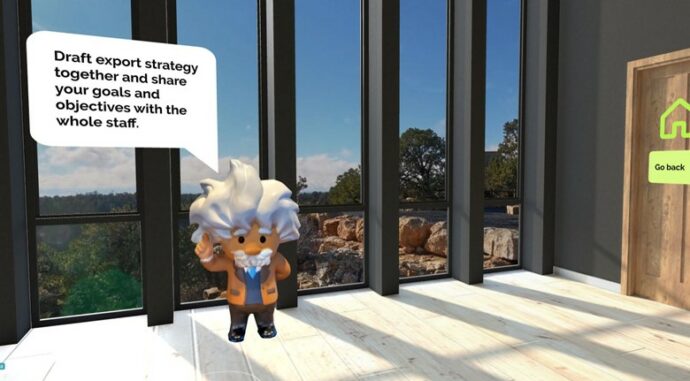Pre-export homework refers to the research, planning, and preparation that companies undertake before expanding to international markets. It involves analyzing market opportunities and competition, understanding customer needs and cultural differences, identifying potential partners, and assessing the feasibility and risks of expansion. Pre-export homework helps businesses to make informed decisions about the market entry, build strong business relationships and improve competitiveness. This article discusses the lessons learned and experiences gained from the VIVA research, development and innovation (RDI) project on the topic.
 Photo by Karolina Grabowska / Pexels
Photo by Karolina Grabowska / Pexels
The VIVA project focuses on the development of the export skills and green growth of small and medium-sized companies (SMEs). The VIVA team identified the need to broaden the scope from the actual export skills training to offering the opportunity to develop the skills needed to start exporting, when the project was joined by companies that were just considering exports. For this purpose, VIVA’s virtual reality environment “Export Skills Basecamp” was extended with a ”Pre-Export Homework” learning environment.
Doing the export homework with care significantly reduces the risks of entering a new market. Lack of preparation may increase, for example, legal and financial risks and supply chain disruptions, thus the VIVA project team saw added value in supporting target companies also at this early stage of the export life cycle. The development work was kick-started by a VIVA coaching webinar and a virtual coffee morning event on this topic.
Export success relies on business readiness and homework well done
The VIVA project experience suggests that in case of the first export transaction for an SME, it is worth doing an acid test at the very beginning. In VIVA, the acid test was defined as a test that allows a company to determine its readiness to export, based on its success in the domestic market. Only if a company passes the acid test it is ready to target international markets. In VIVA’s “Pre-Export Homework” environment, SMEs can implement a self-assessment acid test.
The cases studied by the VIVA team revealed that indicators of export-readiness include, among other things:
- healthy cash flow
- strong balance sheet
- solid sales growth
- recognizable brand name
- loyal customer base.
Additionally, the business model should be scalable and possible to adapt to different markets. SMEs should have access to the necessary resources, such as funding, talent, and technology to support international expansion. (Dixon-Fyle et al, 2020.) Additional factors may be relevant, depending on the specific industry and market.
Market research and competitor analysis play an important role in pre-export homework. The VIVA project allows companies to train their personnel and practise how to conduct them in virtual reality. SMEs can, for example, practise PESTEL analysis to identify the relevant political, economic, sociocultural, technological, environmental, and legal factors that are relevant to the target market. The VIVA learners are also guided to develop their market entry strategies.
Navigating cultural diversity for smooth market entry
The VIVA project introduces businesses to cultural differences using the Hofstede and the Lewis frameworks. These models help SMEs in the export industry to understand the behavior, expectations and values of local customers and better adapt their business strategies to new markets.
The Hofstede model identifies six cultural dimensions that can impact business practices: Power Distance, Individualism vs. Collectivism, Masculinity vs. Femininity, Uncertainty Avoidance, Long-term vs. Short-term Orientation, and Indulgence vs. Restraint. Understanding these dimensions can help exporting SMEs tailor their business practices to the cultural norms of the new market. (Hofstede Insights 2023; Airaksinen 2023.)
The Lewis model, on the other hand, divides cultures into three categories: Linear-Active, Multi-Active, and Reactive. Each of these categories is characterized by different communication styles, attitudes toward time, and other cultural factors that can impact business practices. The VIVA “Pre-Export Homework” environment encourages learners to identify key cultural differences between Finns and representatives of the target market. (Lubin 2013; Airaksinen 2023.)
Assessing the domestic team’s diversity and inclusion is worthwhile
The VIVA “Pre-Export Homework” environment urges SMEs in the export sector to consider also how inclusive their corporate culture is and how diversity is valued, for example in teamwork. Assessing the domestic team’s diversity and inclusion brings benefits to SMEs in the export industry. A diverse and inclusive team fosters creativity, innovation, problem-solving and decision-making. It is also better equipped to understand and connect with a global customer base. Companies that are diverse and promote an inclusive culture can attract not only the best talent but also a wider customer base.
Furthermore, an inclusive work environment promotes employee engagement and retention. This is especially crucial for SMEs in the export industry, where building long-term relationships with international clients is essential for sustainable growth. (Dixon-Fyle et al. 2020; Ely et al 2020; Hunt et al. 2018; Rock & Grant 2016.)
Exploring the Potential of Virtual Reality for Effective Export Homework
The purpose of the VIVA’s virtual reality environments in general is to remind SMEs about the need to invest time in self-learning and discovery, and to foster the intrinsic motivation within companies to seek additional information. They are also designed to boost green growth. The “Pre-Export Homework” environment is closely linked to VIVA’s other environments, such as “Risk-Taking Policy”, “International Trade Agreement Path” and “Know Your Customer” (KYC)”. Learning is activated by quizzes and insightful lines from the talking Einstein character.
 Figure 1: Talking Einstein character in the VIVA’s ”Pre-Export Homework” environment.
Figure 1: Talking Einstein character in the VIVA’s ”Pre-Export Homework” environment.
The strength of the VIVA environments is that they can be customized by SMEs themselves to meet their unique needs and requirements. This can include information and learning opportunities based on the SME’s industry, target market, and specific challenges.
At best, SMEs can simulate real-world scenarios, interact with virtual customers and competitors, and test the impact of their decisions in a safe and controlled environment. This can provide a hands-on and experiential learning experience, which can be engaging and effective for SMEs. (Heiskanen, Kuhmonen & Heino 2023.) However, virtual tours, workshops, and other simulations may require some upfront investment of time and resources to develop, and SMEs often complain that they only have time and resources for day-to-day business. This is a big challenge that has also been encountered in the VIVA project. The VIVA project team has tried to facilitate learning by providing tutorials, instructional videos and consultancy services on how to use the platform, including one-on-one training sessions or access to a dedicated support team that can provide guidance and troubleshooting as needed.
Some of VIVA’s target companies have been forced by Russia’s war in Ukraine and sanctions to leave Russian trade and seek new target markets in countries such as Uzbekistan or Kazakhstan. The VIVA team believes that building their own virtual environment would serve these companies perfectly, as they need to acquire a huge amount of knowledge about new target market and skills related to the trade with those countries in a very short period of time. In the future, it would then be convenient to update the environment as knowledge and understanding increases through experience, and trade with these new countries becomes more established.
For future skills development projects, the VIVA project team together with target companies have identified some potential applications of WondaVR or other virtual reality tools:
- Virtual tours to showcase factory or product in action or customer success stories or testimonials to build interest and trust with potential buyers.
- Interactive product demos and testing to help potential clients understand the features and benefits of the products and to provide feedback.
- Virtual tours of different countries for language and cultural training.
- Soft skills training in virtual workshops to improve power skills, such as negotiation, interaction with buyers or other stakeholders and leadership.
- Virtual role-playing exercises to practice interacting with potential clients or partners from different cultural backgrounds to navigate cultural differences in a business setting.
- Collaboration forums with the possibility of peer discussions and feedback to share the insights and learn from other’s experiences.
In summary, it can be concluded that pre-export homework is demanding and time-consuming and should not be taken lightly. SMEs can leverage virtual reality in various ways to do their homework. They can create virtual reality experiences that can improve customer experience, marketing and training, while enhancing efficiency and productivity. By leveraging virtual reality, SMEs can differentiate themselves from competitors, boost sales, and ultimately achieve greater success in their export efforts. However, SMEs should evaluate different options to find the tool or technology that best meets their needs and objectives.
More information on the VIVA project:
The purpose of the VIVA – Virtual Technologies Boost SME Exports project, funded by the Helsinki–Uusimaa Regional Council, is to provide SMEs with a new way to simulate and practice export trade interactions. The project encounters export trade, modern technologies and continuous learning. Modern technologies refer to Augmented Reality (AR) and Virtual Reality (VR).
Homepage: www.vivaboost.fi
Sources:
- Airaksinen, P. 2022. How to Select a Target Market & Market Entry Strategies. VIVA Project’s “Power up Green Export Skills” Webinar 2.11.2022.
- Airaksinen, P. 2023. International Business and Culture. VIVA Project’s Virtual Morning Coffee Event 2.2.2023.
- Dixon-Fyle, S., Dolan, K., Hunt D.V. & Prince, S. 2020. Diversity wins. How inclusion matters. Report. McKinsey & Company. Retrieved 20.4.2023.
- Ely, R.J. & Thomas, D.A. 2020. Getting Serious About Diversity: Enough Already with the Business Case. Harvard Business Review. Retrieved 20.4.2023.
- Gerschewski, S, Scott-Kennel, J. & Rose, E.L. 2020. Ready to export? The role of export readiness for superior export performance of small and medium‐sized enterprises. The World Economy, 43 (5). pp. 1253-1276. ISSN 0378- 5920. Retrieved 15.4.2023.
- Hofstede Insights. 2023. Country Comparison. Retrieved 20.4.2023.
- Hunt, D.V., Yee, L., Prince, S. & Dixon-Fyle, S. 2018. Delivering through diversity. Report. McKinsey & Company. Retrieved 20.4.2023.
- Kuhmonen, A., Heiskanen, M. & Heino, P. 2023. On scenario-based microlearning journey. Laurea Journal. Retrieved 24.4.2023.
- Lubin, G. 2013. The Lewis Model Explains Every Culture In The World. Business Insider. Retrieved 20.4.2023.
- Rock, D. & Grant, H. 2016. Why Diverse Teams Are Smarter. Harvard Business Review. Retrieved 20.4.2023.